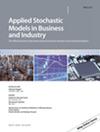求助PDF
{"title":"相关重尾随机变量更新模型的联合尾概率及其在系统风险度量中的应用","authors":"Lei Zou, Jiangyan Peng, Chenghao Xu","doi":"10.1002/asmb.70028","DOIUrl":null,"url":null,"abstract":"<div>\n \n <p>Consider a non-standard renewal risk model in which claims arrive in pairs <span></span><math>\n <semantics>\n <mrow>\n <mo>{</mo>\n <mo>(</mo>\n <msub>\n <mrow>\n <mi>X</mi>\n </mrow>\n <mrow>\n <mn>1</mn>\n <mi>i</mi>\n </mrow>\n </msub>\n <mo>,</mo>\n <msub>\n <mrow>\n <mi>X</mi>\n </mrow>\n <mrow>\n <mn>2</mn>\n <mi>i</mi>\n </mrow>\n </msub>\n <mo>)</mo>\n <mo>;</mo>\n <mi>i</mi>\n <mo>∈</mo>\n <mi>ℕ</mi>\n <mo>}</mo>\n </mrow>\n <annotation>$$ \\left\\{\\left({X}_{1i},{X}_{2i}\\right);i\\in \\mathbb{N}\\right\\} $$</annotation>\n </semantics></math> and the stochastic discounting process is given by <span></span><math>\n <semantics>\n <mrow>\n <mo>{</mo>\n <msup>\n <mrow>\n <mi>e</mi>\n </mrow>\n <mrow>\n <mo>−</mo>\n <mi>ξ</mi>\n <mo>(</mo>\n <mi>t</mi>\n <mo>)</mo>\n </mrow>\n </msup>\n <mo>;</mo>\n <mi>t</mi>\n <mo>≥</mo>\n <mn>0</mn>\n <mo>}</mo>\n </mrow>\n <annotation>$$ \\left\\{{e}^{-\\xi (t)};t\\ge 0\\right\\} $$</annotation>\n </semantics></math>, where <span></span><math>\n <semantics>\n <mrow>\n <mi>ξ</mi>\n <mo>(</mo>\n <mo>·</mo>\n <mo>)</mo>\n </mrow>\n <annotation>$$ \\xi \\left(\\cdotp \\right) $$</annotation>\n </semantics></math> is a Lévy process. We are interested in the joint tail probability of <span></span><math>\n <semantics>\n <mrow>\n <msub>\n <mrow>\n <mi>L</mi>\n </mrow>\n <mrow>\n <mn>1</mn>\n </mrow>\n </msub>\n <mo>(</mo>\n <mi>t</mi>\n <mo>)</mo>\n </mrow>\n <annotation>$$ {L}_1(t) $$</annotation>\n </semantics></math> and <span></span><math>\n <semantics>\n <mrow>\n <msub>\n <mrow>\n <mi>L</mi>\n </mrow>\n <mrow>\n <mn>2</mn>\n </mrow>\n </msub>\n <mo>(</mo>\n <mi>t</mi>\n <mo>)</mo>\n </mrow>\n <annotation>$$ {L}_2(t) $$</annotation>\n </semantics></math>, the aggregate discounted claims along the respective lines <span></span><math>\n <semantics>\n <mrow>\n <mi>k</mi>\n <mo>=</mo>\n <mn>1</mn>\n <mo>,</mo>\n <mn>2</mn>\n </mrow>\n <annotation>$$ k=1,2 $$</annotation>\n </semantics></math>. Assume that <span></span><math>\n <semantics>\n <mrow>\n <mo>{</mo>\n <mo>(</mo>\n <msub>\n <mrow>\n <mi>X</mi>\n </mrow>\n <mrow>\n <mn>1</mn>\n <mi>i</mi>\n </mrow>\n </msub>\n <mo>,</mo>\n <msub>\n <mrow>\n <mi>X</mi>\n </mrow>\n <mrow>\n <mn>2</mn>\n <mi>i</mi>\n </mrow>\n </msub>\n <mo>)</mo>\n <mo>;</mo>\n <mi>i</mi>\n <mo>∈</mo>\n <mi>ℕ</mi>\n <mo>}</mo>\n </mrow>\n <annotation>$$ \\left\\{\\left({X}_{1i},{X}_{2i}\\right);i\\in \\mathbb{N}\\right\\} $$</annotation>\n </semantics></math> is a sequence of independent and identically distributed random pairs with generic pair <span></span><math>\n <semantics>\n <mrow>\n <mo>(</mo>\n <msub>\n <mrow>\n <mi>X</mi>\n </mrow>\n <mrow>\n <mn>1</mn>\n </mrow>\n </msub>\n <mo>,</mo>\n <msub>\n <mrow>\n <mi>X</mi>\n </mrow>\n <mrow>\n <mn>2</mn>\n </mrow>\n </msub>\n <mo>)</mo>\n </mrow>\n <annotation>$$ \\left({X}_1,{X}_2\\right) $$</annotation>\n </semantics></math>. Further assume that <span></span><math>\n <semantics>\n <mrow>\n <mo>(</mo>\n <msub>\n <mrow>\n <mi>X</mi>\n </mrow>\n <mrow>\n <mn>1</mn>\n </mrow>\n </msub>\n <mo>,</mo>\n <msub>\n <mrow>\n <mi>X</mi>\n </mrow>\n <mrow>\n <mn>2</mn>\n </mrow>\n </msub>\n <mo>)</mo>\n </mrow>\n <annotation>$$ \\left({X}_1,{X}_2\\right) $$</annotation>\n </semantics></math> follows a dependence structure encompassing both tail dependence and tail independence, and has regularly varying marginal tails. We derive asymptotic formulas for the joint tail probability of <span></span><math>\n <semantics>\n <mrow>\n <msub>\n <mrow>\n <mi>L</mi>\n </mrow>\n <mrow>\n <mn>1</mn>\n </mrow>\n </msub>\n <mo>(</mo>\n <mi>t</mi>\n <mo>)</mo>\n </mrow>\n <annotation>$$ {L}_1(t) $$</annotation>\n </semantics></math> and <span></span><math>\n <semantics>\n <mrow>\n <msub>\n <mrow>\n <mi>L</mi>\n </mrow>\n <mrow>\n <mn>2</mn>\n </mrow>\n </msub>\n <mo>(</mo>\n <mi>t</mi>\n <mo>)</mo>\n </mrow>\n <annotation>$$ {L}_2(t) $$</annotation>\n </semantics></math>. These results are then applied to evaluate two systemic risk measures. Finally, we conduct numerical studies to illustrate the theoretical findings.</p>\n </div>","PeriodicalId":55495,"journal":{"name":"Applied Stochastic Models in Business and Industry","volume":"41 4","pages":""},"PeriodicalIF":1.5000,"publicationDate":"2025-07-29","publicationTypes":"Journal Article","fieldsOfStudy":null,"isOpenAccess":false,"openAccessPdf":"","citationCount":"0","resultStr":"{\"title\":\"Joint Tail Probability of Renewal Models of Dependent Heavy-Tailed Random Variables With Applications to Systemic Risk Measures\",\"authors\":\"Lei Zou, Jiangyan Peng, Chenghao Xu\",\"doi\":\"10.1002/asmb.70028\",\"DOIUrl\":null,\"url\":null,\"abstract\":\"<div>\\n \\n <p>Consider a non-standard renewal risk model in which claims arrive in pairs <span></span><math>\\n <semantics>\\n <mrow>\\n <mo>{</mo>\\n <mo>(</mo>\\n <msub>\\n <mrow>\\n <mi>X</mi>\\n </mrow>\\n <mrow>\\n <mn>1</mn>\\n <mi>i</mi>\\n </mrow>\\n </msub>\\n <mo>,</mo>\\n <msub>\\n <mrow>\\n <mi>X</mi>\\n </mrow>\\n <mrow>\\n <mn>2</mn>\\n <mi>i</mi>\\n </mrow>\\n </msub>\\n <mo>)</mo>\\n <mo>;</mo>\\n <mi>i</mi>\\n <mo>∈</mo>\\n <mi>ℕ</mi>\\n <mo>}</mo>\\n </mrow>\\n <annotation>$$ \\\\left\\\\{\\\\left({X}_{1i},{X}_{2i}\\\\right);i\\\\in \\\\mathbb{N}\\\\right\\\\} $$</annotation>\\n </semantics></math> and the stochastic discounting process is given by <span></span><math>\\n <semantics>\\n <mrow>\\n <mo>{</mo>\\n <msup>\\n <mrow>\\n <mi>e</mi>\\n </mrow>\\n <mrow>\\n <mo>−</mo>\\n <mi>ξ</mi>\\n <mo>(</mo>\\n <mi>t</mi>\\n <mo>)</mo>\\n </mrow>\\n </msup>\\n <mo>;</mo>\\n <mi>t</mi>\\n <mo>≥</mo>\\n <mn>0</mn>\\n <mo>}</mo>\\n </mrow>\\n <annotation>$$ \\\\left\\\\{{e}^{-\\\\xi (t)};t\\\\ge 0\\\\right\\\\} $$</annotation>\\n </semantics></math>, where <span></span><math>\\n <semantics>\\n <mrow>\\n <mi>ξ</mi>\\n <mo>(</mo>\\n <mo>·</mo>\\n <mo>)</mo>\\n </mrow>\\n <annotation>$$ \\\\xi \\\\left(\\\\cdotp \\\\right) $$</annotation>\\n </semantics></math> is a Lévy process. We are interested in the joint tail probability of <span></span><math>\\n <semantics>\\n <mrow>\\n <msub>\\n <mrow>\\n <mi>L</mi>\\n </mrow>\\n <mrow>\\n <mn>1</mn>\\n </mrow>\\n </msub>\\n <mo>(</mo>\\n <mi>t</mi>\\n <mo>)</mo>\\n </mrow>\\n <annotation>$$ {L}_1(t) $$</annotation>\\n </semantics></math> and <span></span><math>\\n <semantics>\\n <mrow>\\n <msub>\\n <mrow>\\n <mi>L</mi>\\n </mrow>\\n <mrow>\\n <mn>2</mn>\\n </mrow>\\n </msub>\\n <mo>(</mo>\\n <mi>t</mi>\\n <mo>)</mo>\\n </mrow>\\n <annotation>$$ {L}_2(t) $$</annotation>\\n </semantics></math>, the aggregate discounted claims along the respective lines <span></span><math>\\n <semantics>\\n <mrow>\\n <mi>k</mi>\\n <mo>=</mo>\\n <mn>1</mn>\\n <mo>,</mo>\\n <mn>2</mn>\\n </mrow>\\n <annotation>$$ k=1,2 $$</annotation>\\n </semantics></math>. Assume that <span></span><math>\\n <semantics>\\n <mrow>\\n <mo>{</mo>\\n <mo>(</mo>\\n <msub>\\n <mrow>\\n <mi>X</mi>\\n </mrow>\\n <mrow>\\n <mn>1</mn>\\n <mi>i</mi>\\n </mrow>\\n </msub>\\n <mo>,</mo>\\n <msub>\\n <mrow>\\n <mi>X</mi>\\n </mrow>\\n <mrow>\\n <mn>2</mn>\\n <mi>i</mi>\\n </mrow>\\n </msub>\\n <mo>)</mo>\\n <mo>;</mo>\\n <mi>i</mi>\\n <mo>∈</mo>\\n <mi>ℕ</mi>\\n <mo>}</mo>\\n </mrow>\\n <annotation>$$ \\\\left\\\\{\\\\left({X}_{1i},{X}_{2i}\\\\right);i\\\\in \\\\mathbb{N}\\\\right\\\\} $$</annotation>\\n </semantics></math> is a sequence of independent and identically distributed random pairs with generic pair <span></span><math>\\n <semantics>\\n <mrow>\\n <mo>(</mo>\\n <msub>\\n <mrow>\\n <mi>X</mi>\\n </mrow>\\n <mrow>\\n <mn>1</mn>\\n </mrow>\\n </msub>\\n <mo>,</mo>\\n <msub>\\n <mrow>\\n <mi>X</mi>\\n </mrow>\\n <mrow>\\n <mn>2</mn>\\n </mrow>\\n </msub>\\n <mo>)</mo>\\n </mrow>\\n <annotation>$$ \\\\left({X}_1,{X}_2\\\\right) $$</annotation>\\n </semantics></math>. Further assume that <span></span><math>\\n <semantics>\\n <mrow>\\n <mo>(</mo>\\n <msub>\\n <mrow>\\n <mi>X</mi>\\n </mrow>\\n <mrow>\\n <mn>1</mn>\\n </mrow>\\n </msub>\\n <mo>,</mo>\\n <msub>\\n <mrow>\\n <mi>X</mi>\\n </mrow>\\n <mrow>\\n <mn>2</mn>\\n </mrow>\\n </msub>\\n <mo>)</mo>\\n </mrow>\\n <annotation>$$ \\\\left({X}_1,{X}_2\\\\right) $$</annotation>\\n </semantics></math> follows a dependence structure encompassing both tail dependence and tail independence, and has regularly varying marginal tails. We derive asymptotic formulas for the joint tail probability of <span></span><math>\\n <semantics>\\n <mrow>\\n <msub>\\n <mrow>\\n <mi>L</mi>\\n </mrow>\\n <mrow>\\n <mn>1</mn>\\n </mrow>\\n </msub>\\n <mo>(</mo>\\n <mi>t</mi>\\n <mo>)</mo>\\n </mrow>\\n <annotation>$$ {L}_1(t) $$</annotation>\\n </semantics></math> and <span></span><math>\\n <semantics>\\n <mrow>\\n <msub>\\n <mrow>\\n <mi>L</mi>\\n </mrow>\\n <mrow>\\n <mn>2</mn>\\n </mrow>\\n </msub>\\n <mo>(</mo>\\n <mi>t</mi>\\n <mo>)</mo>\\n </mrow>\\n <annotation>$$ {L}_2(t) $$</annotation>\\n </semantics></math>. These results are then applied to evaluate two systemic risk measures. Finally, we conduct numerical studies to illustrate the theoretical findings.</p>\\n </div>\",\"PeriodicalId\":55495,\"journal\":{\"name\":\"Applied Stochastic Models in Business and Industry\",\"volume\":\"41 4\",\"pages\":\"\"},\"PeriodicalIF\":1.5000,\"publicationDate\":\"2025-07-29\",\"publicationTypes\":\"Journal Article\",\"fieldsOfStudy\":null,\"isOpenAccess\":false,\"openAccessPdf\":\"\",\"citationCount\":\"0\",\"resultStr\":null,\"platform\":\"Semanticscholar\",\"paperid\":null,\"PeriodicalName\":\"Applied Stochastic Models in Business and Industry\",\"FirstCategoryId\":\"100\",\"ListUrlMain\":\"https://onlinelibrary.wiley.com/doi/10.1002/asmb.70028\",\"RegionNum\":4,\"RegionCategory\":\"数学\",\"ArticlePicture\":[],\"TitleCN\":null,\"AbstractTextCN\":null,\"PMCID\":null,\"EPubDate\":\"\",\"PubModel\":\"\",\"JCR\":\"Q3\",\"JCRName\":\"MATHEMATICS, INTERDISCIPLINARY APPLICATIONS\",\"Score\":null,\"Total\":0}","platform":"Semanticscholar","paperid":null,"PeriodicalName":"Applied Stochastic Models in Business and Industry","FirstCategoryId":"100","ListUrlMain":"https://onlinelibrary.wiley.com/doi/10.1002/asmb.70028","RegionNum":4,"RegionCategory":"数学","ArticlePicture":[],"TitleCN":null,"AbstractTextCN":null,"PMCID":null,"EPubDate":"","PubModel":"","JCR":"Q3","JCRName":"MATHEMATICS, INTERDISCIPLINARY APPLICATIONS","Score":null,"Total":0}
引用次数: 0
引用
批量引用

 求助内容:
求助内容: 应助结果提醒方式:
应助结果提醒方式:


